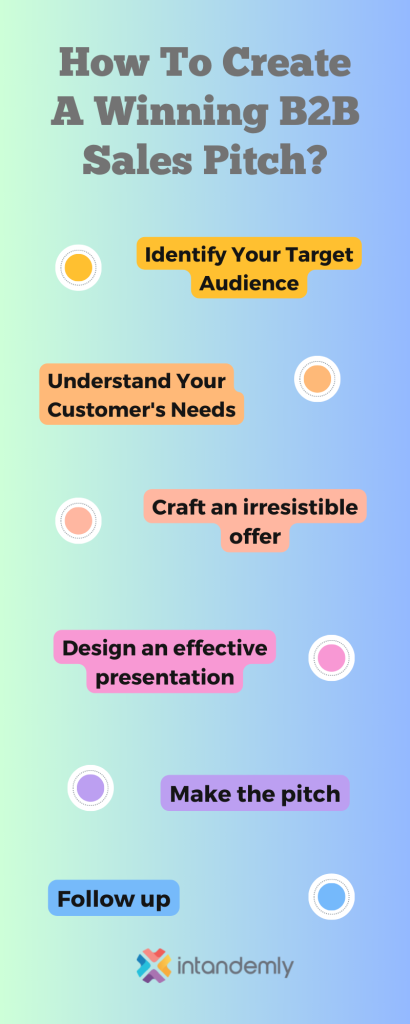How To Create A Winning B2B Sales Pitch?
INTRODUCTION:
Crafting a compelling sales pitch can mean the difference between closing a deal and losing a potential client.Creating a winning B2B sales pitch for B2B products or services can be a challenging task, but with the right approach, it can be achieved. To create a winning B2B sales pitch that will capture your audience’s attention, start with a good introduction. In this blog post, we'll explore some key strategies and tips to help you create a sales pitch that will effectively communicate the value of your B2B product or service.
ELEMENTS OF A B2B SALES PITCH
A B2B sales pitch serves as a compelling presentation of your product or service to a prospective business client. Its primary objective is to demonstrate how your offering can effectively address their challenges, fulfill their requirements, and bring significant value. However, the question remains: how can you develop a B2B sales pitch that distinguishes itself in a crowded marketplace and persuades your prospects to engage?Below mentioned are the esential elements of
1.A Strong Introduction: Your introduction is your chance to make a great first impression. It should be concise and engaging, introducing yourself and your company. Use a hook or a compelling statistic to pique your audience's interest. The goal is to get them to listen further.
2.A Clear Problem: Identify and define the problem or pain point that your product or service addresses. It's crucial to demonstrate that you understand your audience's challenges. The more relatable and relevant this problem is to your audience, the more likely they are to engage with your pitch.
3.A Compelling Solution: Once the problem is established, present your product or service as the solution. Explain how it effectively addresses the identified problem. Use language that is easy to understand, avoiding jargon or overly technical terms. Make it clear how your solution can make the prospect's life better or easier.
4.Convincing Benefits: Highlight the key benefits of your product or service. Focus on the benefits that matter most to your specific audience. Whether it's cost savings, increased efficiency, improved productivity, or something else, emphasize how your solution delivers value. Provide evidence or examples that illustrate these benefits.
5.Social Proof: To build credibility and trust, incorporate social proof into your pitch. This can include statistics, client testimonials, case studies, or endorsements from reputable sources. Real-world examples of how your solution has benefited others can be highly persuasive. Social proof helps reassure your audience that your claims are valid.
6.A Clear Call to Action (CTA):At the end of your pitch, guide your audience on what to do next. Your CTA should be specific, clear, and actionable. Whether you want them to schedule a demo, sign up for a free trial, or make a purchase, be direct in your request. Make it as easy as possible for your prospect to take the next step.
How To Create A Winning B2B Sales Pitch?
Introduction:
Introduce the company and briefly explain who you are and what the company does. Then, explain why that product or service is helpful to the customer and how it is better than similar products or services on the market.
Identify Your Target Audience
Having a clear understanding of your target audience is essential to crafting a successful sales pitch. Consider who you are speaking to and what their needs are. Are you speaking to a small business owner, a corporate executive, or another type of decision-maker? Knowing the needs and interests of your target audience will help you tailor your pitch to those specific needs and make it more effective.
Understand Your Target Audience
To make a truly effective sales pitch, it is important to understand the needs of your target audience. What problems do they need to solve? What solutions can you provide? Make sure to highlight the unique benefits of your product or service and how it can help the customer solve their problem.
Understand Your Customer's Needs
It is important to understand your customer's specific needs and how they can be addressed with your product or service. Doing research on the customer and their industry will help you tailor your pitch to their needs, pain points, and desired outcome.
It also helps to understand the competition and how your product or service is different or better in comparison. By understanding the customer's needs, you can create a sales pitch that is tailored to their unique requirements and will be more compelling and successful.

Crafting an irresistible offer
An irresistible offer is so compelling that the customer can't refuse it. To create an irresistible offer, you need to understand your target market and what they value. This includes understanding their pain points, desires, and needs.
Once you have a good understanding of your target market, you can create an offer that addresses their specific needs and desires. It should be unique and provide clear value to the customer.
Examples of irresistible offers include:
- A limited-time discount or promotion.
- A free trial or demo.
- A money-back guarantee.
- A bundle deal that includes multiple products or services at a discounted price.
- A complimentary service or consultation.
Designing an effective presentation
An effective presentation captures the audience's attention, is easy to understand, and leaves a lasting impression. To create an effective presentation, you should:
- Use visual aids to help convey your message.
- Tailor your content to your audience's needs and level of understanding.
- Keep it simple and avoid using jargon.
- Use storytelling to make your message more relatable.
- Practice your delivery and timing to ensure a smooth presentation.
Making the pitch
The pitch is the moment when you present your offer to the potential customer. To make an effective pitch, you should be able to communicate the value of your offer and how it addresses the customer's specific needs and desires. It is important to be confident and enthusiastic when making the pitch, but also to be respectful and not pushy.
Be prepared for any objections that the customer may have and have answers ready. Also, be prepared for questions and be transparent about any risks or limitations of your offer.
Following up
Following up is the process of staying in touch with potential customers after the initial pitch. This can be done through phone calls, emails with Email Marketing Software, or in-person meetings.
The goal of following up is to build a relationship with the potential customer and to keep your offer top of mind. It also allows you to address any objections or concerns that the customer may have and to provide any additional information or resources that may be helpful. Timing is important, so be sure not to follow up too frequently and be respectful of the customer's time.
By following these tips, you can create a compelling sales pitch that will help you effectively market your B2B product or service to potential customers.
Here are some quick tips for creating an effective B2B sales pitch for companies:
- Identify the pain points of your target customers: Understanding the challenges that your potential customers are facing will help you tailor your pitch to their specific needs.
- Show how your product or service can solve their problems: Your pitch should clearly demonstrate how your offering can address the pain points of your target customers and provide them with a solution.
- Provide evidence of your product's effectiveness: Use data and customer testimonials to back up your claims about the benefits of your product or service.
- Highlight the value of your product: Emphasize the ROI (return on investment) that your customers can expect from using your product or service.
- Use storytelling to engage your audience: Instead of simply listing the features of your product, try using storytelling to bring your pitch to life and make it more relatable for your audience.
- Use visual aids: Using visual aids, such as slides or videos, can help you illustrate your points and keep your audience engaged.
- End with a call to action: Make sure to clearly outline the next steps that your audience should take, whether it's scheduling a demo or requesting more information.
5 Templates for B2B Sales Pitch
Creating a B2B sales pitch from scratch can be daunting, but a solid template can provide a helpful starting point. Here are five versatile templates you could consider:
- Problem-Solution Template: Start by identifying a common problem or challenge your target audience faces in their industry or operations. Then, introduce your product or service as the robust solution that addresses this issue effectively.
- Comparison Template: Differentiate your offering by highlighting its unique features and benefits in relation to your competitors. Show your prospects why your product or service is the superior choice in the market.
- Testimonial Template: Leverage success stories or testimonials from satisfied customers to build trust and credibility. Real-world examples of how your product has benefited others can be a powerful persuasive tool.
- Value Proposition Template: Clearly outline your product's value proposition. Explain how it can enhance the customer's business operations, improve their financial performance, or help them achieve their strategic goals.
- Invitation Template: Extend an invitation for prospects to experience your product or service firsthand. This could be in the form of a free demo, a consultation, a product trial, or a site visit.
CONCLUSION:
In conclusion, selling to other businesses (B2B) requires a different approach than selling to individual consumers (B2C). B2B sales often involve longer sales cycles, multiple decision-makers, and more complex purchasing decisions. To be successful in B2B sales, it's crucial to understand the unique needs and pain points of your target customers and to be able to effectively communicate how your product or service can help solve their problems.
FAQs:
What is a B2B sales pitch?
What are the key elements of a successful B2B sales pitch?
A strong value proposition that shows how your product or service can solve your audience's problems and help them achieve their goals
Compelling evidence in the form of data, testimonials, and case studies to support your value proposition
A clear call to action that tells your audience what you want them to do next (e.g., schedule a demo, sign up for a free trial, or make a purchase).
